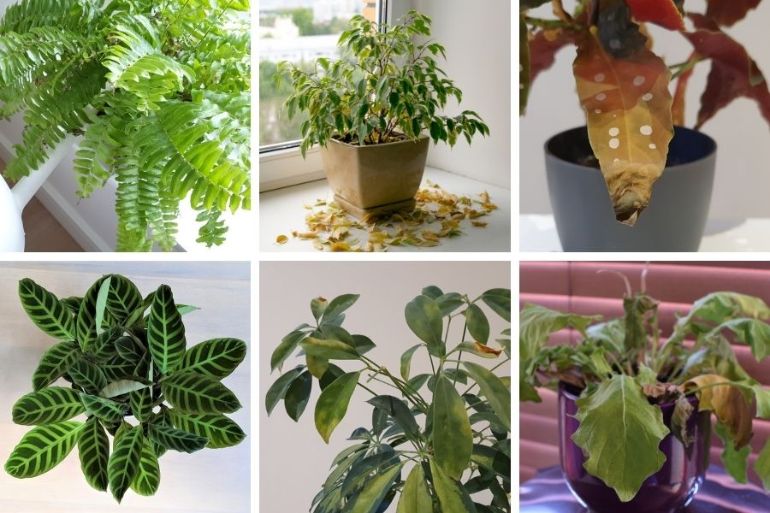Overwatering is one of the most common houseplant problems but it can be difficult to tell the difference between an overwatered and underwatered plant. Knowing whether you are overwatering vs underwatering is essential if you want to keep your houseplants thriving. This article is going to explain how to easily tell the difference between the two and show you how to fix both.
Underwatering plants causes dry leaves, brown tips, leaf drop, wilting, and leaf curling. The soil will feel dry, but the plant will improve after watering. Overwatering causes yellowing leaves, brown tips, wilting despite wet soil, and also symptoms of underwatering if root rot has started.
This article will help you work out if your plant has been overwatered or underwatered, as well as explaining how to prevent both. I’ll explain why both are bad for houseplants, how to fix a plant that is struggling and share my favorite houseplants that can tolerate being over or underwatered.
Signs Of Overwatering Vs Underwatering
| Signs Of Overwatering | Signs Of Underwatering |
| Yellowing of lower leaves | Leaf drop |
| New leaves develop brown tips | Brown tips affecting many leaves |
| The plant stops growing | Slow growth and smaller leaves |
| Wilting that doesn’t resolve after watering | Wilting that improves after watering |
| Offensive smell from the soil | Dry soil |
| Mushy, black/brown roots | Leaves feel papery and thin |
| Leaf edema in early stages | Some yellowing, followed by browning leaves |
| Leaf curling can occur | Leaf curling happens earlier |
What Is Wrong With My Plant? – Overwatering Vs Underwatering
If your plant isn’t happy, but you’re not sure whether it has been overwatered or underwatered, the most important thing to do first is feel the soil. An underwatered plant will always have dry soil. Underwatering is caused by complete water deficiency.
If your plant only has symptoms of underwatering, as outlined above, and the soil feels dry, you should water your plant and watch how it responds over the next 12-24 hours. An underwatered plant will respond quickly by recovering from wilting and looking much healthier.
If the plant has symptoms of both overwatering and underwatering, it is more likely to be overwatered. The damage from overwatering is caused by prolonged wet conditions, but the damage will still be present long after the soil dries out.
Rather than attempting to water your plant to see how it responds, you should carefully examine the conditions your plant has been growing in to see if you can work out for sure what the problem is.
The next section will walk you through exactly what to do, and I’m confident you will be able to correctly diagnose your plant and take the correct actions to try to fix it.
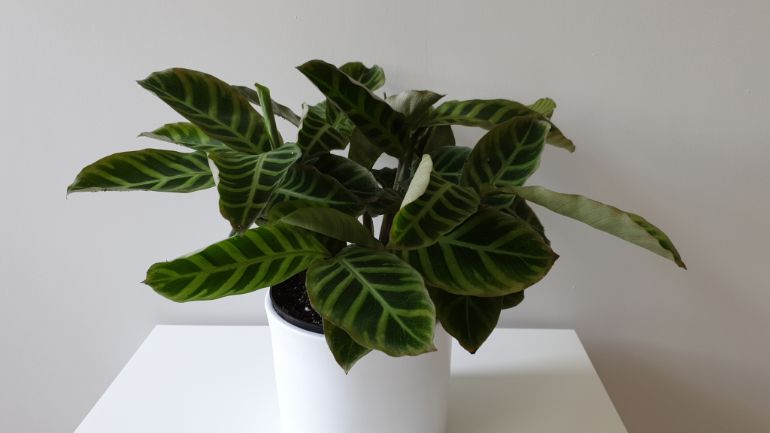
What Is Overwatering?
Overwatering is the term used to describe a plant that has been grown in poorly aerated soil, most commonly due to excessively wet, soggy conditions. Overwatering can be caused by watering too often or growing your plants in conditions that result in the soil staying wet for a prolonged period of time or draining poorly.
The symptoms of overwatering occur due to the roots of the plant being unable to access oxygen for them to survive. It often comes as a surprise for people to learn that the roots of most plants require oxygen to survive. However, a steady supply of oxygenated air delivered through the air spaces of the soil is essential for them to respire.
Plant respiration is the process by which plants use sugars generated by photosynthesis, along with oxygen, to produce energy for the plant to grow and thrive.
Without a steady supply of oxygen, the roots are essentially starved, leaving them unable to function properly, to supply water and nutrients to the rest of the plant, and weak and vulnerable to disease.
How Do You Tell If You Are Overwatering A Plant?
Unhealthy roots are unable to provide nutrients to the leaves, causing them to start to turn yellow. The initial abundance of water can cause blistering and edema of the leaves, but this soon gives way to water deficiency as the roots start to struggle and fail to deliver water and nutrients to the plant. Leaf tips, particularly of young leaves are most susceptible to drought and turn brown first.
Other leaves become dehydrated, papery and thin. As the leaves are responsible for a considerable amount of water loss under normal conditions, many plants start to curl their leaves, or shed them in an attempt to conserve water.
How To Prevent Overwatering
There are a number of simple but important ways to avoid overwatering your plants;
- Ensure good lighting – Plants grow much quicker and use available water in the soil faster when in good lighting. Even “low light” plants do better in bright conditions.
- Use well-draining soil – Add inorganic material to your potting soil, such as perlite, leca, gravel, or pumice to aid drainage and aeration. Water should soak into the soil immediately when watering.
- Avoid cool temperatures – Evaporation and plant growth are increased in warmer temperatures, increasing water use.
- Use pots that are just big enough – Large pots with more soil will take longer to dry out after watering. Putting your plants in a snug pot makes sure they will use all the available water in the soil reasonably quickly.
- Choose pots with plenty of drainage holes – Make sure the drainage holes are right at the bottom of the pot. Make more drainage holes if needed.
- Always check before watering – Check soil dampness, pot weight, and for signs of water stress before watering. Follow these tips to make sure you only water your plants when needed.
- Consider using porous pots – Terracotta pots are porous and will lose water through their walls, reducing the time it takes soil to dry. Read more about pot choices for houseplants here.
How To Fix Overwatering
The most important thing is to identify the early signs and make some changes to the conditions your plant is growing in, as outlined above.
If your plant is struggling with symptoms of overwatering, or you think your plant has root rot, you’ll need to take more significant steps to fix your plant. Just follow these steps to get your plant back on track;
- Gently slide your plant from the pot.
- Inspect the roots carefully. Rotten roots will be black/brown, fragile, mushy, and may smell bad. Healthy roots should be brown or light in color, and firm to the touch.
- Prune off all rotten roots with sterile pruning shears. Take care to sterilize the shears afterwards to prevent transferring nasty bugs to any of your other plants.
- If you have detected root rot, remove all of the soil from the plant. RTemove most gently with your fingers and then rinse off the remainder.
- Consider spraying the roots with dilute hydrogen peroxide spray. This is harmless to the plant, but helps kill any pathogens.
- Repot your plant in a clean pot and fresh, well-draining soil.
- Read up on the care conditions your plant likes best and try to adhere to these. Moderate lighting is better than too much or too little until your plant recovers.
- If you’d like a bit more detail on this process, follow this step by step guide to fix your plant.
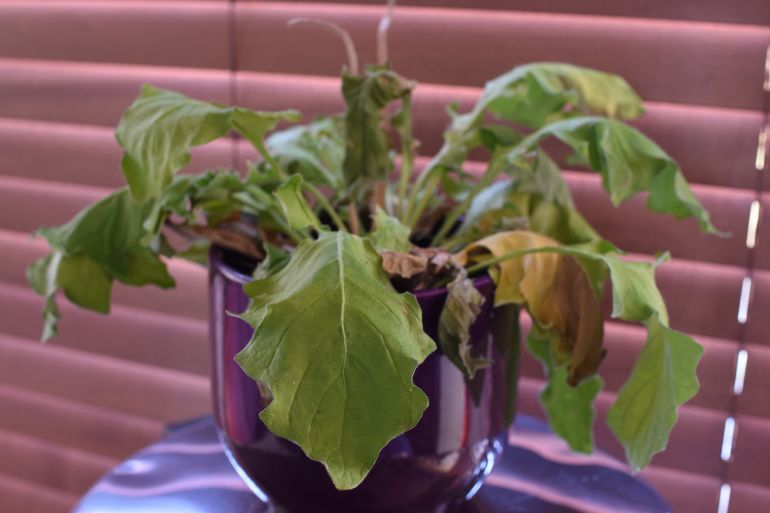
What Is Underwatering
Underwatering is the result of not providing sufficient water to meet the needs of your plant and keep it healthy. Underwatering can be caused by not providing your plant with sufficient water, or be due to excessive water loss from the plant due to its growing conditions.
How Do You Tell If You Are Underwatering A Plant?
Whilst it’s easy to mistakenly think an overwatered plant is suffering from underwatering, it is much easy to identify an underwatered plant. Look for dry, papery leaves, brown leaf tips, leaf curling, wilting, and slow growth.
Although there is some overlap between the symptoms of overwatereing vs underwatering, there is an easy way to be sure what the problem is. An underwatered plant should only have symptoms suggesting water deficiency. An overwatered plant will often have symptoms of both, and this is what can make it a little confusing.
Underwatering is more likely to happen if you have less time to look after your houseplants, or if you are away from home for prolonged periods and unable to water your houseplants.
How To Prevent Underwatering
Once again, there are a few really easy measures you can take to reduce the risk of underwatering your plants.
- Make sure your plant is not rootbound – Most plants fill their pots with roots after a few years, meaning available water is used very quickly. Gently slide your plant out of its pot, and if rootbound, consider repotting in a slightly larger container. See a step-by-step guide here.
- Avoid excess heat or warm drafts – Hot conditions or warm drafts can greatly increase evaporation from the soil and transpiration from your plant. This may result in the soil drying after only a day or two. Try to check the soil every few days to monitor when your plant may need to be watered again.
- Incorrect watering – Make sure to thoroughly soak the soil when you water your plants and let the excess drain. Sometimes water can run right through dry soil without being absorbed. The top of the soil may feel wet, but have the roots had a good drink?
- Arid conditions – Low humidity greatly increases evaporation and water loss. Consider increasing humidity using one of these methods to reduce water loss.
- The wrong choice of soil – Soil with little organic material may drain too well and dry out quickly. Different types of plants will have different preferences for how well-draining or moisture-retentive they like their soil to be.
- Forgetting to water your plants – Sometimes it’s hard to remember to water your houseplants. I think we all find a wilted plant from time to time that we have forgotten about. Try to develop a routine of giving your plants a quick check every few days and water those that need it.
- Self-watering pots, watering globes, or ask someone else to water your plants – There are many options to help you water your plants if you are on vacation or away from home for a while. Make use of all options to keep your plants thriving.
- Seasonal changes – Plant water use changed dramatically from winter to summer. A plant that needs to be watered every two weeks in winter may need watering every two days in summer. This is most likely to catch you out as winter transitions to spring, and your plants start to grow strongly.
Do Yellow Leaves Mean Overwatering Or Underwatering?
Yellow leaves mean chlorosis, which is the breakdown of chlorophyll within the leaves. Overwatering classically causes yellow leaves, usually starting with the lower leaves on most plants. Underwatering can also cause some yellowing of plant leaves, so it is best to look for a combination of symptoms and growing conditions to help you decide between overwatering vs underwatering.
Bear in mind that there are many other causes of yellow leaves on houseplants. The good news is that if you examine your plant closely, taking into consideration the growing conditions as well as the appearance of the plant, you can usually work out what is happening and fix the problem.
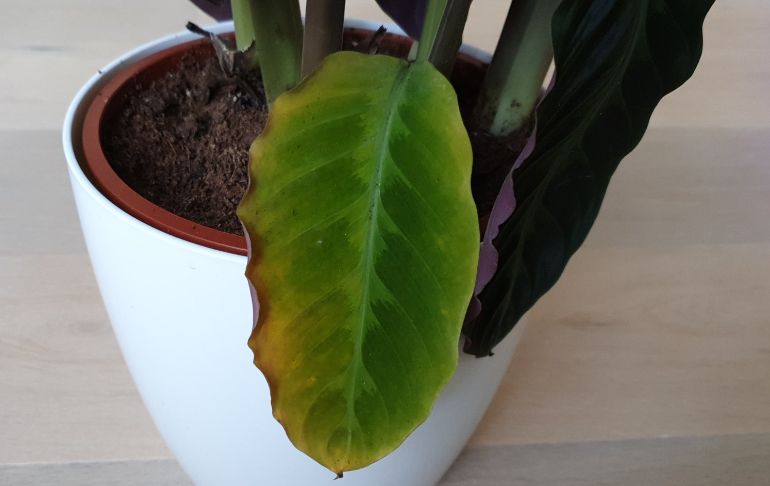
How Long For Plants To Recover From Overwatering
After correcting the factors contributing to overwatering, it will take at least three months for most plants to recover, and usually at least 6 months for them to return to a similar condition they were in before the problem.
I had a recent experience of overwatering a Calathea zebrina, which presented with generally yellowing leaves, with brown tips and leaf curling. I had to prune off at least half the affected foliage, prune some roots affected by root rot and repot the plant in new soil and a new pot.
It took about three months before I had any new growth. The plant remained relatively stable during this time, with minimal further decline in the quality of the plant. The plant spent this time growing new roots, and just when I was losing hope, it suddenly burst into life, producing copious new foliage. It took between 6-9 months for it to make a full recovery, but thankfully, it recovered to be even more stunning than it had been before.
Is Overwatering Worse Than Underwatering?
Overwatering is much worse for plants and has a much greater chance of resulting in the plant dying. Overwatering causes much more extensive root damage, which often must be treated by pruning off the affected roots and repotting the plant.
Although underwatering often results in dead leaves and leaf loss, the roots tend to be the last part of the plant to be badly affected, so if you return to a normal watering schedule, there is a good chance the plant will recover. Clearly, this depends on how bad the underwatering has been, as if the plant has died back completely, there may be no prospect of saving it.
Also bear in mind that some plants will not grow new foliage to replace dead leaves, but will only grow from growth points at the extremities of the plant. This can spoil the look of the plant and may impact
What Plants Can Tolerate Underwatering
Thankfully, there are plenty of houseplants that are quite tolerant to underwatering, These plants can often go for weeks without water, and will be very forgiving if you forget to water them from time to time. All of the following are very popular and suitable for beginners but are also loved by houseplant enthusiasts
- ZZ Plant
- Snake Plant
- Jade Plant
- Spider Plant
- Ponytail Palm
- Cast Iron Plant
- Aloe Vera
- Cacti – Many, many different types
What Plants Are Most Resistant To Overwatering
There are far fewer plants that can tolerate overwatering, as all plants require their roots to have oxygen supplied to their roots for respiration. Here are a few that can tolerate overwatering better than most.
- Lucky Bamboo
- Baby’s Tears
- Moss
- Boston Fern
- Anthuriums
- Areca Palms
- Umbrella Plant
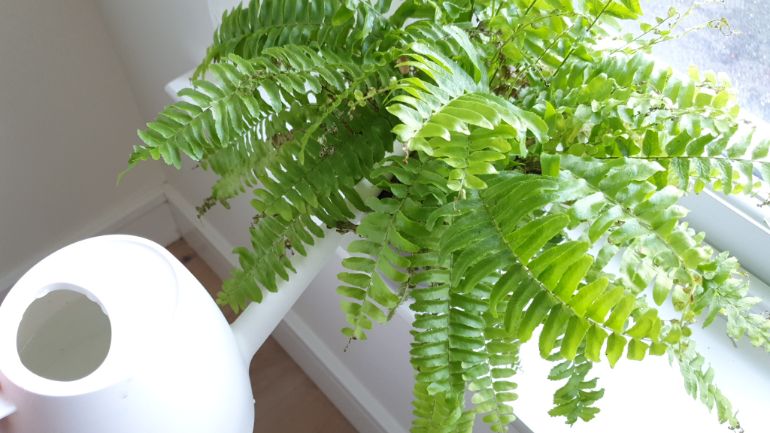
Why Can Some Plants Grow In Water, But Not In Wet Soil?
Many houseplants can be grown in water, rather than soil. This can initially be confusing when so many can’t even tolerate growing in wet soil. However, the key point to remember that overwatering is actually a problem with root oxygenation, rather than water availability.
Water has a considerable amount of dissolved oxygen in it, and the constant circulation of water causes more oxygen from the air to dissolve in the water, replenishing the supply that is used by plants in the water.
In contrast, waterlogged soil is filled with water that becomes stuck in place, and has minimal contact with the surface. The roots will use available oxygen within the water next to them, but as this water does not circulate, the dissolved oxygen is not replenished.
To make matters worse, the air spaces of the soil are completely filled with water, so no air can circulate to the roots. The consequence is that the roots become hypoxic and weak. This is often the time for opportunistic bacteria and fungi to attack the roots, leading to their demise and the onset of root rot.
Last Word
I hope I’ve helped you navigate the tricky topic of overwatering vs underwatering. It takes a little practice to read what is happening to your plants, but with a little experience, you’ll find you can easily understand what your plants are telling you.
If you’d like to learn a little more about growing beautiful, healthy houseplants, you should check out some of the articles below. You should also take a look at my book, “Houseplants Made Easy” that can turn you into a confident indoor gardener, able to grow beautiful, healthy houseplants with ease.
- 8 Ways To Tell When Your Houseplants Need To Be Watered
- How To Care For Succulents Indoors
- Phalaenopsis Orchid Care For Beginners
- How To Fix Yellow Leaves On Houseplants
- 25 Hard To Kill Houseplants That Will Thrive In Your Home
- Why Is My Houseplant Wilting?
- Understanding Light Requirements For Indoor Plants
- What Pots To Use For Indoor Plants

